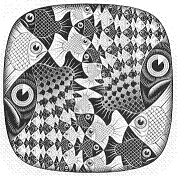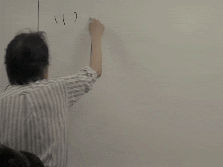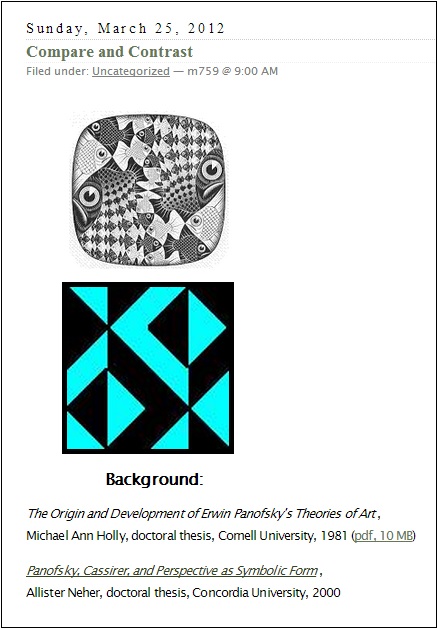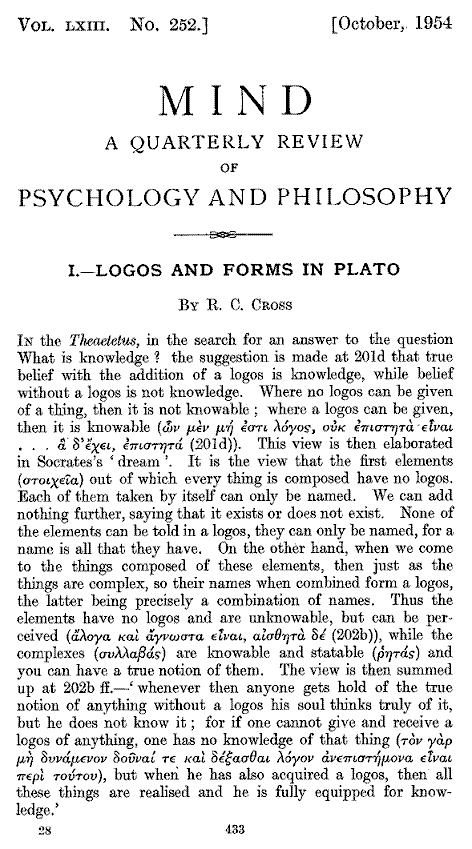Sunday, April 9, 2023
Symbolic Form
Monday, January 4, 2021
The Purloined Joke
Sunday, June 29, 2014
Sunday School
See also Panofsky’s Perspective as Symbolic Form in an online PDF.
Sunday, March 25, 2012
Compare and Contrast


Background:
The Origin and Development of Erwin Panofsky's Theories of Art ,
Michael Ann Holly, doctoral thesis, Cornell University, 1981 (pdf, 10 MB)
Panofsky, Cassirer, and Perspective as Symbolic Form ,
Allister Neher, doctoral thesis, Concordia University, 2000
Saturday, June 26, 2010
Plato’s Logos
"The present study is closely connected with a lecture* given by Prof. Ernst Cassirer at the Warburg Library whose subject was 'The Idea of the Beautiful in Plato's Dialogues'…. My investigation traces the historical destiny of the same concept…."
* See Cassirer's Eidos und Eidolon : Das Problem des Schönen und der Kunst in Platons Dialogen, in Vorträge der Bibliothek Warburg II, 1922/23 (pp. 1–27). Berlin and Leipzig, B.G. Teubner, 1924.
— Erwin Panofsky, Idea: A Concept in Art Theory, foreword to the first German edition, Hamburg, March 1924
On a figure from Plato's Meno—

The above figures illustrate Husserl's phrase "eidetic variation"—
a phrase based on Plato's use of eidos, a word
closely related to the word "idea" in Panofsky's title.
For remarks by Cassirer on the theory of groups, a part of
mathematics underlying the above diamond variations, see
his "The Concept of Group and the Theory of Perception."
Sketch of some further remarks—

The Waterfield question in the sketch above
is from his edition of Plato's Theaetetus
(Penguin Classics, 1987).
The "design theory" referred to in the sketch
is that of graphic design, which includes the design
of commercial logos. The Greek word logos
has more to do with mathematics and theology.
"If there is one thread of warning that runs
through this dialogue, from beginning to end,
it is that verbal formulations as such are
shot through with ambiguity."
— Rosemary Desjardins, The Rational Enterprise:
Logos in Plato's Theaetetus, SUNY Press, 1990
Related material—
Tuesday, May 25, 2010
Sisteen
"Nuvoletta in her lightdress, spunn of sisteen shimmers,
was looking down on them, leaning over the bannistars….
Fuvver, that Skand, he was up in Norwood's sokaparlour…."
— Finnegans Wake
To counteract the darkness of today's 2:01 AM entry—
Part I— Artist Josefine Lyche describes her methods—
A— "Internet and hard work"
B— "Books, both fiction and theory"
Part II— I, too, now rely mostly on the Internet for material. However, like Lyche, I have Plan B— books.
Where I happen to be now, there are piles of them. Here is the pile nearest to hand, from top to bottom.
(The books are in no particular order, and put in the same pile for no particular reason.)
- Philip Rieff— Sacred Order/Social Order, Vol. I: My Life Among the Deathworks
- Dennis L. Weeks— Steps Toward Salvation: An Examination of Coinherence and Substitution in the Seven Novels of Charles Williams
- Erwin Panofsky— Idea: A Concept in Art Theory
- Max Picard— The World of Silence
- Walter J. Ong, S. J.— Hopkins, the Self, and God
- Richard Robinson— Definition
- X. J. Kennedy and Dana Gioia, eds.— An Introduction to Poetry
- Richard J. Trudeau— The Non-Euclidean Revolution
- William T. Noon, S. J.— Joyce and Aquinas
- Munro Leaf— Four-and-Twenty Watchbirds
- Jane Scovell— Oona: Living in the Shadows
- Charles Williams— The Figure of Beatrice
- Francis L. Fennell, ed.— The Fine Delight: Centenary Essays on the Poetry of Gerard Manley Hopkins
- Hilary Putnam— Renewing Philosophy
- Paul Tillich— On the Boundary
- C. S. Lewis— George MacDonald
Lyche probably could easily make her own list of what Joyce might call "sisteen shimmers."
Friday, February 22, 2008
Friday February 22, 2008
the idea of identity:
what it is to give
something a name
on Monday
and have it respond
to that name
on Friday….”
— Bernard Holland in
The New York Times
Monday, May 20, 1996
In 1564,
artist Michelangelo
died in Rome.

Idea: A Concept
in Art Theory
… Todo lo sé por el lucero puro
que brilla en la diadema de la Muerte
— Rubén Darío
Related material:
Yesterday’s entry
and Anthony Lane
in this week’s
New Yorker:
Sunday, November 4, 2007
Sunday November 4, 2007
Talking of Michelangelo:
On this date in 1948, T. S. Eliot
won the Nobel Prize in Literature.

Idea: A Concept in Art Theory
Friday, October 5, 2007
Friday October 5, 2007

A man returns a crucifix
to a Huichol village chapel.
![]()
Scheidewege, “crossroads.”)
Wednesday, October 3, 2007
Wednesday October 3, 2007

Will Hunting may be
interested in the following
vacant editorships at
The Open Directory:
Graph Theory
and
Combinatorics.
Related material:
The Long Hello and
On the Holy Trinity —
"Hey, Carrie-Anne, what's
your game now….?"
Picture sources:
azstarnet.com,
vibrationdata.com.
Personally, I prefer
Carol Ann:
From Criticism, Fall, 2001,
by Carol Ann Johnston—
|
"Drawing upon Platonic thought, Augustine argues that ideas are actually God's objective pattern and as such exist in God's mind. These ideas appear in the mirror of the soul. (35)." (35.) In Augustine, De Trinitate, trans., Stephen McKenna (Washington, D.C.: Catholic University Press, 1970). See A. B. Acton, "Idealism," in The Encyclopedia of Philosophy, ed., Paul Edwards. Vol. 4 (New York: Macmillan, 1967): 110-118; Robert McRae, "`Idea' as a Philosophical Term in the Seventeenth Century," JHI 26 (1965): 175-190, and Erwin Panofsky, Idea: A Concept in Art History, trans., Joseph J. S. Peake (Columbia, S.C.: University of South Carolina Press, 1968) for explications of this term. |
Art Wars: Geometry as Conceptual Art
and Ideas and Art: Notes on Iconology.
For more on Augustine and geometry,
see Today's Sinner (Aug. 28, 2006).
Monday, October 1, 2007
Monday October 1, 2007
"Definitive"
— The New York Times,
Sept. 30, 2007, on
Blade Runner:
The Final Cut
"The art historian Kirk Varnedoe died on August 14, 2003, after a long and valiant battle with cancer. He was 57. He was a faculty member in the Institute for Advanced Study’s School of Historical Studies, where he was the fourth art historian to hold this prestigious position, first held by the German Renaissance scholar Erwin Panofsky in the 1930s."
Varnedoe chose to introduce his final lecture with the less-quoted last words of the android Roy Batty (Rutger Hauer) in Ridley Scott's film Blade Runner: 'I've seen things you people wouldn't believe– attack ships on fire off the shoulder of Orion, bright as magnesium; I rode on the back decks of a blinker and watched C-beams glitter in the dark near the Tannhauser Gate. All those moments will be lost in time, like tears in the rain. Time to die.'"
Saturday, September 29, 2007
Saturday September 29, 2007
From The New York Times
on the Feast of
St. Michael and All Angels:

Recommended reading in the afterlife
for Rabbi Shapira:
“The Man as Pure as Lucifer,”
by Graham Greene
Recommended viewing in the afterlife
for Dr. Panofsky, son of Erwin Panofsky:
“Pray for the grace of accuracy.”
— Robert Lowell, quoted in
a web page titled
“Is Nothing Sacred?“
“The page numbers are
generally reliable.”
— Steven H. Cullinane,
“Zen and Language Games“
Related material:
Sacred Passion:
The Art of William Schickel,
U. of Notre Dame Press, 1998
Click on the fingerpost
for further details.
Thursday, April 7, 2005
Thursday April 7, 2005
In the Details
Wallace Stevens,
An Ordinary Evening in New Haven:
XXII
Professor Eucalyptus said, "The search
For reality is as momentous as
The search for God." It is the philosopher's search
For an interior made exterior
And the poet's search for the same exterior made
Interior….
… Likewise to say of the evening star,
The most ancient light in the most ancient sky,
That it is wholly an inner light, that it shines
From the sleepy bosom of the real, re-creates,
Searches a possible for its possibleness.
Julie Taymor, "Skewed Mirrors" interview:
"… they were performing for God. Now God can mean whatever you want it to mean. But for me, I understood it so totally. The detail….
They did it from the inside to the outside. And from the outside to the in. And that profoundly moved me then. It was…it was the most important thing that I ever experienced."
The above may be of interest to students
of iconology — what Dan Brown in
The Da Vinci Code calls "symbology" —
and of redheads.
The artist of Details,
"Brenda Starr" creator
Dale Messick, died on Tuesday,
April 5, 2005, at 98.
For further details on
April 5, see
Art History:
The Pope of Hope

Tuesday, April 5, 2005
Tuesday April 5, 2005
The Pope of Hope

At the Vatican on
Shakespeare's Birthday
Oct. 4, 2002)
See also the iconology —
what Dan Brown in
The Da Vinci Code
calls "symbology" —
of Pandora's Box
at Log24.net,
March 10, 2005:

each containing the key to the other."
"Karol Wojtyla had looked into
the heart of darkness–
and at the heart of darkness
discovered reason
for an indomitable hope.
He lived on the far side of
the greatest catastrophe
in human history,
the death of the Son of God,
and knew that evil
did not have the last word.
This is the key…."
— Richard John Neuhaus,
April 4, 2005

Finnegans Wake, p. 293,
"the lazily eye of his lapis"

at the center of the breaking and
redefining of the Classical system."

Skewed Mirrors,
Sept. 14, 2003
"Evil did not have the last word."
— Richard John Neuhaus, April 4, 2005
| Lps. The keys to. Given! A way a lone a last a loved a long the PARIS, |
"There is never any ending to Paris."
— Ernest Hemingway
For the first word, see Louis Armand on
Lethe, erinnerung, and riverrun.
See also the following passage,
linked to on the Easter Vigil, 2005:
a spring,
And by the side thereof standing
a white cypress.
To this spring approach not near.
But you shall find another,
from the lake of Memory
Cold water flowing forth, and there are
guardians before it.
Say, "I am a child of Earth and starry Heaven;
But my race is of Heaven alone.
This you know yourselves.
But I am parched with thirst and I perish.
Give me quickly
The cold water flowing forth
from the lake of Memory."
Friday, February 20, 2004
Friday February 20, 2004
The Da Vinci Code
and Symbology at Harvard
The protagonist of the recent bestseller The Da Vinci Code is Robert Langdon, "a professor of Religious Symbology at Harvard University." A prominent part in the novel is played by the well-known Catholic organization Opus Dei. Less well known (indeed, like Langdon, nonexistent) is the academic discipline of "symbology." (For related disciplines that do exist, click here.) What might a course in this subject at Harvard be like?
|
Harvard Crimson, April 10, 2003: While Opus Dei members said that they do not refer to their practices of recruitment as "fishing," the Work’s founder does describe the process of what he calls "winning new apostles" with an aquatic metaphor. Point #978 of The Way invokes a passage in the New Testament in which Jesus tells Peter that he will make him a "fisher of men." The point reads:
|


Exercise for Symbology 101:
Describe the symmetry
in each of the pictures above.
Show that the second picture
retains its underlying structural
symmetry under a group of
322,560 transformations.
Having reviewed yesterday's notes
on Gombrich, Gadamer, and Panofsky,
discuss the astrological meaning of
the above symbols in light of
today's date, February 20.
Extra credit:
Relate the above astrological
symbolism to the four-diamond
symbol in Jung's Aion.
Happy metaphors!
Thursday, February 19, 2004
Thursday February 19, 2004
What is Poetry, Part II —
Gombrich vs. Gadamer
Excerpts from
Tetsuhiro Kato on
Gombrich and the
Hermeneutics of Art
Kato on Gombrich
“… according to Gombrich, an image is susceptible to become a target for ‘symbol detectives’…. But the hidden authorial intention… ([for example]… astrology, recalling the famous warning of Panofsky [1955: 32]), almost always tends to become a reproduction of the interpreter’s own ideological prejudice. Not to give into the irrationalism such psychological overinterpretation might invite…. we have to look for the origin of meaning… in… the social context…. The event of image making is not the faithful transcription of the outside world by an innocent eye, but it is the result of the artist’s act of selecting the ‘nearest equivalence’… based on social convention….”
Kato on Gadamer
“For [Gadamer], picture reading is a process where a beholder encounters a picture as addressing him or her with a kind of personal question, and the understanding develops in the form of its answer (Gadamer 1981: 23-24; Gadamer 1985: 97,102-103). But, it must be noted that by this Gadamer does not mean to identify the understanding of an image with some sort of ‘subsumption’ of the image into its meaning (Gadamer 1985: 100). He insists rather that we can understand an image only by actualizing what is implied in the work, and engage in a dialogue with it. This process is ideally repeated again and again, and implies different relations than the original conditions that gave birth to the work in the beginning (Gadamer 1985: 100).
What matters here for Gadamer is to let the aesthetic aspect of image take its own ‘Zeitgestalt’ (Gadamer 1985: 101).”
Example (?) — the Zeitgestalt
of today’s previous entry:
See, too,
The Quality of Diamond.
Kato’s References:
Gadamer, Hans-Georg. 1981. “Philosophie und Literatur: Was ist die Literatur?,” Phänomenologische Forschungen 11 (1981): 18-45.
Gadamer, Hans-Georg. 1985. “Über das Lesen von Bauten und Bildern.” Modernität und Tradition: Festschrift für Max Imdahl zum 60. Geburtstag. Ed. Gottfried Boehm, Karlheinz Stierle, Gundorf Winter. Munchen: Wilhelm Fink. 97-103.
Panofsky, Erwin. 1955. Meaning in the Visual Arts: Papers in and on Art History. New York: Anchor.












